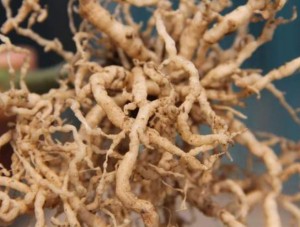Characteristics and control measures of root-knot nematodes
As the temperature decreases, the ventilation in the room decreases, so the root killer “root knot nematode” will harm crops in large quantities. Many farmers report that once the shed becomes sick, they can only wait to die.
Once root-knot nematodes occur in the shed, do you have to wait to die? of course not. Root-knot nematodes harm many crops, especially melons, nightshades and other crops. Fruit trees such as citrus and apples will also encounter this “disaster”. It is considered one of the most difficult subterranean pests to control because the worms hide in the root system.
Once root-knot nematodes occur in fruits and vegetables such as tomatoes and peppers, the leaves of the plants begin to turn yellow and wilt at noon. In the late stage of root-knot nematode occurrence, the plants of fruits and vegetables such as tomatoes and peppers are dwarfed, the leaves are small and yellow, and finally the whole plant withers and dies.
Today, let’s talk about the root-knot nematode, the most difficult “root killer” for this farmer.
Symptoms of root-knot nematode infestation on plants
Generally, lateral roots and branch roots are the most vulnerable, and there are no beaded tumor-like objects behind the injury, and there are white female nematodes after cutting them. The symptoms of the aerial parts are shrinkage and yellowing, wilting and dying when the weather is dry. Severely diseased plants grow weak, dwarf and yellow.
On crops such as celery, fibrous roots and lateral buds will appear bead-like nodules of varying sizes, and the aerial parts will gradually wilt at noon and turn yellow, and the plants are relatively short and stunted. In severe cases, the roots turn brown until they rot and die.
Affected plants have more lateral roots than normal, and bead-like nodules are formed on the fibrous roots. Early-rising root-knot nematodes form yellowish granules, which then turn into yellow-brown granules.
How to prevent root-knot nematodes?
Don’t work together! Don’t work together! Don’t work together! This is especially important to note!
When buying fruit-bearing vegetables such as tomatoes and cucumbers, or when raising seedlings by yourself, you should carefully check the roots for root-knot nematode damage.
Crop rotation. Plant green onions, garlic and other crops in the middle of the ridges of fruits and vegetables such as tomatoes and cucumbers.
When the disease is serious, excavate the diseased plants in time, excavate all and sprinkle with quicklime, and re-bury the map. If the disease is not serious, abamectin, avimidacloprid, thiazophosphine, etc. can be used for root irrigation.
